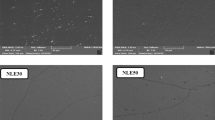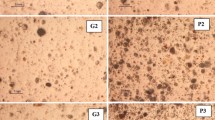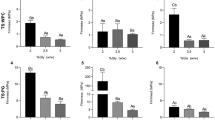Abstract
In the present study, the effects of type and concentration of plasticizer on an edible film based on milk proteins concentrate were investigated. To achieve this goal, three numerical factors of glycerol concentration (5, 7, and 9% W/V), sorbitol concentration (5, 7, and 9% W/V), and Nigella sativa L. essential oil (NSEO) content (0, 1, and 2% W/V) were evaluated using a Box–Behnken design. Then, optimization was performed using the desirability function based on the minimum values of moisture content and water vapor permeability, as well as the maximum whiteness index. Scanning electron microscopy, Fourier-transform infrared spectroscopy, differential scanning calorimetry, and mechanical tests were used to examine the microscopic structure, functional groups, thermal characteristics, such as melting point, and mechanical properties, respectively. The optimal conditions to produce edible films were obtained using 5% glycerol, 5% sorbitol, and 1.27% NSEO. The results of SEM analysis showed typical morphological characteristics of protein-based films containing essential oils for the optimum film. The mechanical analysis showed that the tensile strength and Young’s modulus of the films decrease and the elongation increases with an increasing amount of plasticizer and adding NSEO. The melting temperature of the optimal film was about 130 °C.






Similar content being viewed by others
References
Mohamed SA, El-Sakhawy M, El-Sakhawy MAM (2020) Polysaccharides, protein and lipid-based natural edible films in food packaging: a review. Carbohydr Polym 238:116178
Rezaei M, Pirsa S, Chavoshizadeh S (2019) Photocatalytic/antimicrobial active film based on wheat gluten/ZnO nanoparticles. J Inorg Organomet Polym 30:2654–2665
Sani IK, Marand SA, Alizadeh M, Amiri S, Asdagh A (2020) Thermal, mechanical, microstructural and inhibitory characteristics of sodium caseinate based bioactive films reinforced by ZnONPs/Encapsulated melissa officinalis essential oil. J Inorg Organomet Polym 31:261–271
Majeed A, Muhammad Z, Ahmad H, Hayat SSS, Inayat N, Siyyar S (2020) Nigella sativa L.: uses in traditional and contemporary medicines—an overview. Acta Ecol Sin https://doi.org/10.1016/j.chnaes.2020.02.001
Mouwakeh A, Kincses A, Nové M, Mosolygó T, Mohácsi-Farkas C, Kiskó G, Spengler G (2019) Nigella sativa essential oil and its bioactive compounds as resistance modifiers against Staphylococcus aureus. Phytother Res 33(4):1010–1018
Mukhtar H, Qureshi AS, Anwar F, Mumtaz MW, Marcu M (2019) Nigella sativa L. seed and seed oil: potential sources of high-value components for development of functional foods and nutraceuticals/pharmaceuticals. J Essent Oil Res 31(3):171–183
Sokmen A, Abdel-Baki AAS, Al-Malki ES, Al-Quraishy S, Abdel-Haleem HM (2020) Constituents of essential oil of Origanum minutiflorum and its in vitro antioxidant, scolicidal and anticancer activities. J King Saud Univ Sci 32(4):2377–2382
Ait Mbarek L, Ait Mouse H, Elabbadi N, Bensalah M, Gamouh A, Aboufatima R, Benharref A, Chait A, Kamal M, Dalal A, Zyad A (2007) Anti-tumor properties of blackseed (Nigella sativa L.) extracts. Braz J Med Biol Res 40(6):839–847
Erkan N, Ayranci G, Ayranci E (2008) Antioxidant activities of rosemary (Rosmarinus officinalis L.) extract, blackseed (Nigella sativa L.) essential oil, carnosic acid, rosmarinic acid and sesamol. Food Chem 110(1):76–82
Jouki M, Mortazavi SA, Yazdi FT, Koocheki A (2014) Characterization of antioxidant–antibacterial quince seed mucilage films containing thyme essential oil. Carbohydr Polym 99:537–546
Zubair M, Ullah A (2020) Recent advances in protein derived bionanocomposites for food packaging applications. Crit Rev Food Sci Nutr 60(3):406–434
Karaca OB, Oluk CA, Taşpinar T, Güven M (2019) New concept in packaging: milk protein edible films. In: Health and safety aspects of food processing technologies Springer, Cham, pp 537–565
Ye A (2011) Functional properties of milk protein concentrates: emulsifying properties, adsorption and stability of emulsions. Int Dairy J 21(1):14–20
Rodríguez M, Oses J, Ziani K, Mate JI (2006) Combined effect of plasticizers and surfactants on the physical properties of starch based edible films. Food Res Int 39(8):840–846
Lee MS, Lee SH, Ma YH, Park SK, Bae DH, Ha SD, Song KB (2005) Effect of plasticizer and cross-linking agent on the physical properties of protein films. Prevent Nutr Food Sci 10(1):88–91
Perez-Gago MB, Krochta JM (2001) Denaturation time and temperature effects on solubility, tensile properties, and oxygen permeability of whey protein edible films. J Food Sci 66(5):705–710
Bakry NF, Isa MIN, Sarbon NM (2017) Effect of sorbitol at different concentrations on the functional properties of gelatin/carboxymethyl cellulose (CMC)/chitosan composite films. Int Food Res J 24(4):1753
Fabra M, Talens P, Chiralt A (2010) Water sorption isotherms and phase transitions of sodium caseinate–lipid films as affected by lipid interactions. Food Hydrocoll 24(4):384–391
Moghanjougi ZM, Bari MR, Khaledabad MA, Almasi H, Amiri S (2020) Bio-preservation of white brined cheese (Feta) by using probiotic bacteria immobilized in bacterial cellulose: optimization by response surface method and characterization. LWT 117:108603
Barshan S, Bari MR, Almasi H, Amiri S (2019) Optimization and characterization of bacterial cellulose produced by Komagatacibacterxylinus PTCC 1734 using vinasse as a cheap cultivation medium. Int J Biol Macromol 136:1188–1195
Amiri S, Mokarram RR, Khiabani MS, Bari MR, Khaledabad MA (2019) Exopolysaccharides production by Lactobacillus acidophilus LA5 and Bifidobacteriumanimalis subsp. lactis BB12: optimization of fermentation variables and characterization of structure and bioactivities. Int J Biol Macromol 123:752–765
Sadeghnezhad Z, Amiri S, Rezazadeh-Bari M, Almasi H (2020) Physical and morphological characteristics of edible composite film of sodium caseinate/pectin/zedo gum containing poulk (stachysschtschegleevii) extract: optimizing bioactivity and physicochemical properties. J Packag Technol Res. https://doi.org/10.1007/s41783-020-00094-w
Asdagh A, Sani IK, Pirsa S, Amiri S, Shariatifar N, Eghbaljoo–Gharehgheshlaghi H, Shabahang Z, Taniyan A (2021) Production and characterization of nanocomposite film based on whey protein isolated/copper oxide nanoparticles containing coconut essential oil and paprika extract. J Polym Environ 29:335–349
Pirsa S, Farshchi E, Roufegarinejad L (2020) Antioxidant/antimicrobial film based on carboxymethyl cellulose/gelatin/TiO2–Ag nano-composite. J Polym Environ 28(12):3154–3163
Jouki M, Khazaei N, Ghasemlou M, HadiNezhad M (2013) Effect of glycerol concentration on edible film production from cress seed carbohydrate gum. Carbohydr Polym 96(1):39–46
Jouki M, Yazdi FT, Mortazavi SA, Koocheki A (2013) Physical, barrier and antioxidant properties of a novel plasticized edible film from quince seed mucilage. Int J Biol Macromol 62:500–507
Razavi SMA, Amini AM, Zahedi Y (2015) Characterisation of a new biodegradable edible film based on sage seed gum: influence of plasticiser type and concentration. Food Hydrocoll 43:290–298
Rahmawati M, Arief M, Satyantini WH (2019) The effect of sorbitol addition on the characteristic of carrageenan edible film. Earth Environ Sci 236:1–8
Tong Q, Xiao Q, Lim LT (2013) Effects of glycerol, sorbitol, xylitol and fructose plasticisers on mechanical and moisture barrier properties of pullulan–alginate–carboxymethylcellulose blend films. Int J Food Sci Technol 48(4):870–878
Hosseini MH, Razavi SH, Mousavi MA (2009) Antimicrobial, physical and mechanical properties of chitosan-based films incorporated with thyme, clove and cinnamon essential oils. J Food Process Preserv 33(6):727–743
Mostafavi FS, Kadkhodaee R, Emadzadeh B, Koocheki A (2016) Preparation and characterization of tragacanth–locust bean gum edible blend films. Carbohydr Polym 139:20–27
Chick J, Hernandez RJ (2002) Physical, thermal, and barrier characterization of casein-wax-based edible films. J Food Sci 67(3):1073–1079
Arfat YA, Benjakul S, Prodpran T, Sumpavapol P, Songtipya P (2014) Properties and antimicrobial activity of fish protein isolate/fish skin gelatin film containing basil leaf essential oil and zinc oxide nanoparticles. Food Hydrocoll 41:265–273
Hromiš NM, Lazić VL, Markov SL, Vaštag ŽG, Popović SZ, Šuput DZ, Džinić NR, Velićanski AS, Popović LM (2015) Optimization of chitosan biofilm properties by addition of caraway essential oil and beeswax. J Food Eng 158:86–93
Ojagh SM, Rezaei M, Razavi SH, Hosseini SMH (2010) Development and evaluation of a novel biodegradable film made from chitosan and cinnamon essential oil with low affinity toward water. Food Chem 122(1):161–166
Atarés L, Bonilla J, Chiralt A (2010) Characterization of sodium caseinate-based edible films incorporated with cinnamon or ginger essential oils. J Food Eng 100(4):678–687
Bourtoom T, Chinnan MS (2008) Preparation and properties of rice starch–chitosan blend biodegradable film. LWT Food Sci Technol 41(9):1633–1641
Lin HC, Wang BJ, Weng YM (2020) Development and characterization of sodium caseinate edible films cross-linked with genipin. LWT 118:108813
Khazaei N, Esmaiili M, Djomeh ZE, Ghasemlou M, Jouki M (2014) Characterization of new biodegradable edible film made from basil seed (Ocimumbasilicum L.) gum. Carbohydr Polym 102:199–206
Pereda M, Ponce AG, Marcovich NE, Ruseckaite RA, Martucci JF (2011) Chitosan-gelatin composites and bi-layer films with potential antimicrobial activity. Food Hydrocoll 25(5):1372–1381
Siripatrawan U, Harte BR (2010) Physical properties and antioxidant activity of an active film from chitosan incorporated with green tea extract. Food Hydrocoll 24(8):770–775
Bahram S, Rezaei M, Soltani M, Kamali A, Ojagh SM, Abdollahi M (2014) Whey protein concentrate edible film activated with cinnamon essential oil. J Food Process Preserv 38(3):1251–1258
Paluszkiewicz C, Stodolak E, Hasik M, Blazewicz M (2011) FT-IR study of montmorillonite–chitosan nanocomposite materials. Spectrochim Part A Mol Biomol Spectrosc 79(4):784–788
Siracusa V, Romani S, Gigli M, Mannozzi C, Cecchini JP, Tylewicz U, Lotti N (2018) Characterization of active edible films based on citral essential oil, alginate and pectin. Materials 11(10):1980
Scartazzini L, Tosati JV, Cortez DH, Rossi MJ, Flôres SH, Hubinger MD, Di Luccio M, Monteiro AR (2019) Gelatin edible coatings with mint essential oil (Menthaarvensis): film characterization and antifungal properties. J Food Sci Technol 56(9):4045–4056
Ferreira AS, Nunes C, Castro A, Ferreira P, Coimbra MA (2014) Influence of grape pomace extract incorporation on chitosan films properties. Carbohydr Polym 113:490–499
de Souza Silva R, Santos BMM, Fonseca GG, Prentice C, Cortez-Vega WR (2020) Analysis of hybrid sorubim protein films incorporated with glycerol and clove essential oil for packaging applications. J Polym Environ 28(2):421–432
Mohammadi B, Pirsa S, Alizadeh M (2019) Preparing chitosan–polyaniline nanocomposite film and examining its mechanical, electrical, and antimicrobial properties. Polym Polym Compos 27(8):507–517
Asadi S, Pirsa S (2020) Production of biodegradable film based on polylactic acid, modified with lycopene pigment and TiO2 and studying its physicochemical properties. J Polym Environ 28:433–444
Author information
Authors and Affiliations
Corresponding author
Additional information
Publisher's Note
Springer Nature remains neutral with regard to jurisdictional claims in published maps and institutional affiliations.
Rights and permissions
About this article
Cite this article
Ghamari, M.A., Amiri, S., Rezazadeh-Bari, M. et al. Physical, mechanical, and antimicrobial properties of active edible film based on milk proteins incorporated with Nigella sativa essential oil. Polym. Bull. 79, 1097–1117 (2022). https://doi.org/10.1007/s00289-021-03550-y
Received:
Revised:
Accepted:
Published:
Issue Date:
DOI: https://doi.org/10.1007/s00289-021-03550-y




